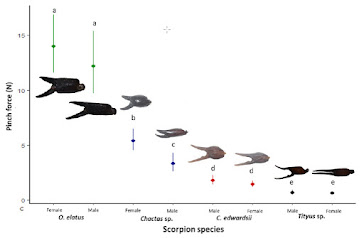Morphological differences in pedipalps and cauda have an impact in prey capture tactics, sting use and venom use in scorpions. Scorpions with large, powerful pedipalps will often not use their stinger and rely on the power of the pedipalps compared to species with more slender pedipalp. Also, the type of prey (defenses, restistance ability etc.) has an impact on the scorpion's prey capture strategies.
Luis Fernando García and co-workers have recently published a study testing how scorpion species with different pincher morphologies and venom efficacies use the pedipalps and the stinger differently during prey capture.
Not surprisingly they found that species with massive pinchers and high pinch force used the stinger less for prey subjugation than species with slender pinchers. They also found that species with robust pinchers had a greater pinch force than species with more slender pinchers.
Abstract:
Background: Scorpions can use their pincers and/or stingers to subdue and immobilize their prey. A scorpion can thus choose between strategies involving force or venom, or both, depending on what is required to subdue its prey. Scorpions vary greatly in the size and strength of their pincers, and in the efficacy of their venom. Whether this variability is driven by their defensive or prey incapacitation functionis unknown. In this study, we test if scorpion species with different pincer morphologies and venom efficacies use these weapons differently during prey subjugation. To that end, we observed Opisthacanthus elatus and Chactas sp. with large pincers and Centruroides edwardsii and Tityus sp. with slender pincers.
Methods: The scorpion pinch force was measured, and behavioral experiments were performed with hard and soft prey (Blaptica dubia and Acheta domesticus). Stinger use, sting frequency and immobilization time were measured.
Results: We found that scorpions with large pincers such as O. elatus produce more force and use the stinger less, mostly subjugating prey by crushing them with the pincers. In C. edwardsii and Tityus sp. we found they use their slender and relatively weak pincers for holding the prey, but seem to predominantly use the stinger to subjugate them. On the other hand, Chactas sp. uses both strategies although it has a high pinch force.
Conclusions: Our results show that scorpionspecies with massive pincers and high pinch force as O. elatus use the stinger less for prey subjugation than scorpionspecies with slender pincers.
Reference:
Garcia LF, Valenzuela-Rojas JC, Gonzalez-Gomez JC, Lacava M, Meijden Avd. Pinching or stinging? Comparing prey capture among scorpions with contrasting morphologies. J Venom Anim Toxins Incl Trop Dis. 2022;28:e20210037. [Open Access]


No comments:
Post a Comment